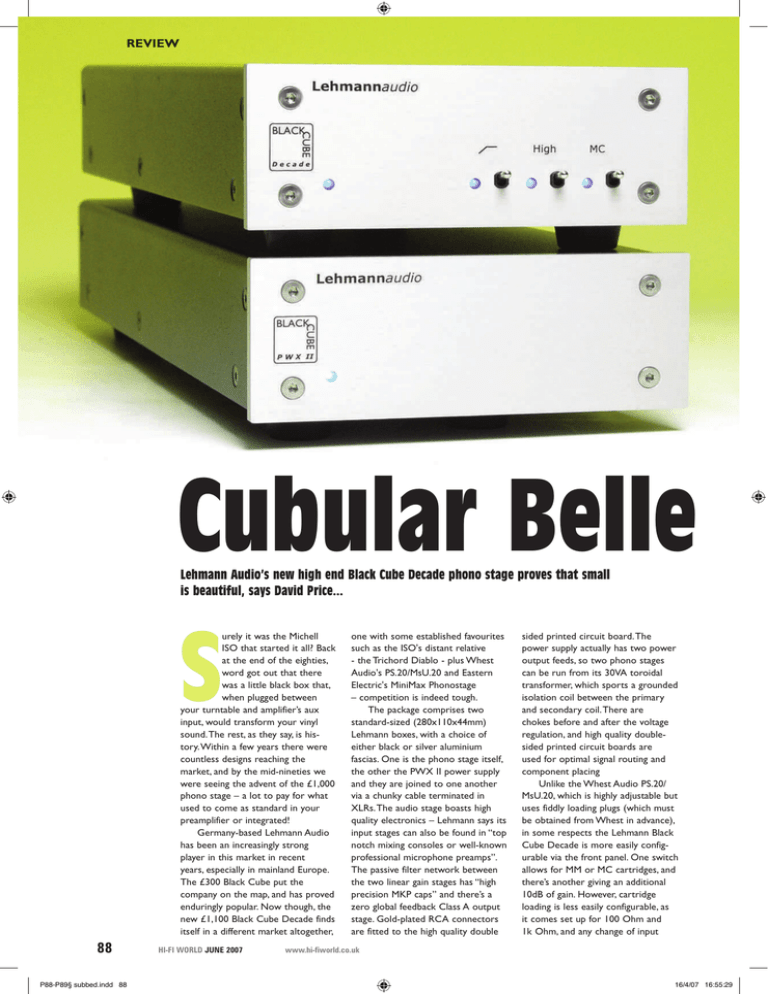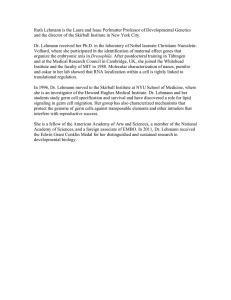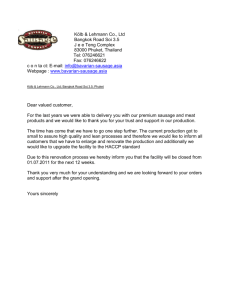Lehmann Audio`s new high end Black Cube Decade phono stage
advertisement

REVIEW Cubular Belle S Lehmann Audio’s new high end Black Cube Decade phono stage proves that small is beautiful, says David Price... urely it was the Michell ISO that started it all? Back at the end of the eighties, word got out that there was a little black box that, when plugged between your turntable and amplifier’s aux input, would transform your vinyl sound. The rest, as they say, is history. Within a few years there were countless designs reaching the market, and by the mid-nineties we were seeing the advent of the £1,000 phono stage – a lot to pay for what used to come as standard in your preamplifier or integrated! Germany-based Lehmann Audio has been an increasingly strong player in this market in recent years, especially in mainland Europe. The £300 Black Cube put the company on the map, and has proved enduringly popular. Now though, the new £1,100 Black Cube Decade finds itself in a different market altogether, 88 P88-P89§ subbed.indd 88 HI-FI WORLD JUNE 2007 one with some established favourites such as the ISO's distant relative - the Trichord Diablo - plus Whest Audio's PS.20/MsU.20 and Eastern Electric's MiniMax Phonostage – competition is indeed tough. The package comprises two standard-sized (280x110x44mm) Lehmann boxes, with a choice of either black or silver aluminium fascias. One is the phono stage itself, the other the PWX II power supply and they are joined to one another via a chunky cable terminated in XLRs. The audio stage boasts high quality electronics – Lehmann says its input stages can also be found in “top notch mixing consoles or well-known professional microphone preamps”. The passive filter network between the two linear gain stages has “high precision MKP caps” and there’s a zero global feedback Class A output stage. Gold-plated RCA connectors are fitted to the high quality double sided printed circuit board. The power supply actually has two power output feeds, so two phono stages can be run from its 30VA toroidal transformer, which sports a grounded isolation coil between the primary and secondary coil. There are chokes before and after the voltage regulation, and high quality doublesided printed circuit boards are used for optimal signal routing and component placing Unlike the Whest Audio PS.20/ MsU.20, which is highly adjustable but uses fiddly loading plugs (which must be obtained from Whest in advance), in some respects the Lehmann Black Cube Decade is more easily configurable via the front panel. One switch allows for MM or MC cartridges, and there’s another giving an additional 10dB of gain. However, cartridge loading is less easily configurable, as it comes set up for 100 Ohm and 1k Ohm, and any change of input www.hi-fiworld.co.uk 16/4/07 16:55:29 REVIEW SOUND QUALITY First things first, and in my system at least, I found the Black Cube Decade’s performance was severely hampered by the supplied mains lead – a change to a Black Rhodium Fusion (£81/m) made a dramatic difference. I also placed the audio box on four Bright Star IsoNode feet, which really moved it forward in terms of clarity and musicality for around £20. I compared it to my solid-state reference, the Whest Audio PS.20/MsU.20, which was also thus set-up. Properly fettled, the Black Cube proved a state-of-the-art £1,000 solid-stage phono stage, giving away little to either the Whest or the Trichord Diablo at the price – but that is not to say it sounds the same... If the Trichord were at the far left of our scale – very musically engaging and propulsive, then the Lehmann would be at the right, and the Whest in the middle. By this I mean that it is a silky sounding solid-stater with lots of detail and space, but doesn’t have the vim that the Trichord or (less so) the Whest possess. This is interesting, because until recently I thought the Whest was on the ultra smooth and analytical side of things – and here we have something that makes it seem quite rough and ready! Don’t get me wrong, I am not about to lapse into cliché and call it a typically Teutonic ‘hi-fi’ sounding device that tells you everything that’s happening but doesn’t involve you – that is not the case. But it has what I’d call a ‘studio sound’, inasmuch as it is technically excellent but lacking in any real character of its own. There are two schools of believers here – Noel loves the joie de vivre of the Eastern Electric tube stage, whereas I often find myself going more towards this type of presentation, which is obviously more detailed, better architecturally and more ‘technical’ sounding. Still, one listen to the Note Products PhoNote tube phono stage (at nearly twice the price of the Lehmann) and I find I can be pulled back to valves! The Crusaders’ ‘Street Life’ saw the Lehmann offering a wide open window on the music. Most striking is the proportionality. Whereas valve stages like the Eastern Electric throw you right in the ‘stalls’, the Lehmann puts you on the best seat in the balcony, where you can hear how everything relates to everything else in the mix with total precision. By the same token, it’s a less intense emotional experience, but it’s that classic trade-off. The Whest puts you in the circle, by the way, just a bit closer to the proceedings, but retains an excellent sense of scale despite its greater immediacy. The midband is excellent then, vibration then I don’t think it would VERDICT but in a solid-state sort of way. Like have got the reception it did, which Excellent solid-state phono stage with Naim amplifiers, it doesn’t major on was very positive. Surely it wouldn’t tremendous detailing and a silky sound, telling you about the tonal texturing hurt the company to throw in at but faces stiff competition from tube of the instruments in question. It’s least a slightly better mains lead with and transistor designs alike. smooth and almost silky tonally, but their top phono stage? Likewise, LEHMANN BLACK CUBE everything sounds this way, even these two pressed steel £1,100 DECADE £1,100 the raw clarinets on The Crusaders boxes lack the mechanical vibration Henley Designs ‘Rodeo Drive’. Instead, the Lehmann resistance of a £300 Trichord Dino. +44 (0)1235 511166 focuses on the start and stop points Still, in the end, the top Lehmann www.lehmannaudio.de of notes, and how they all fit together delivered the goods very nicely FOR in the big musical jigsaw puzzle that is thank you very much. It has a - detail the mix. To wit, it’s very fast and clear wonderfully spacious sound, and is - perspective across the bass, mid and treble. truly exceptional in this respect at - space Another one of its talents – and the price, with fine dimensionality, - smoothness this is only when it’s isolated and dynamics and a very natural, airy powered by a decent mains cable – is treble. As such, it comes heartily dynamics. It is deceptively dynamic in recommended, but it won’t suit those AGAINST fact, and enjoys signposting the subtle who place immediacy over accuracy, - set-up dependent accents of Robert Fripp’s guitar as for whom there are many choices. much as it does snare drums being assaulted by a young Keith Moon. The Charlatans' ‘Then’ The Black Cube Decade offers High Frequency response (MM&MC) and Low gain with either MM or MC 20Hz-96kHz proved great fun – it’s cartridges. MM Low was very low at Separation (MM, MC) 68/78dB a busy mix, somewhat x60, x100 being a common minimum, Noise (MM/MC) 0.24/0.07uV dull sounding but very and High will be most useful, as MM Distortion 0.001% brooding, and the cartridges rarely give more than 5mV Gain x60, x184 x628, x1908 Lehmann did its stuff or so output when playing an LP. With Overload 8.8V out by cutting through the MC at High there is enough gain even dirge like a hot knife for low output types, although only just. MM FREQUENCY RESPONSE through butter, throwing With insensitive amplifiers of 400mV or out a wide, well more, volume will have to be turned up proportioned recorded a little, but this should not be a problem as the Decade is reasonably quiet at acoustic and masses of detail. Bass was taut and 0.074uV equivalent input noise, if not up with the best that manage 0.04uV tuneful, midband clear - around 5dB quieter. and spacious and treble Equalisation was deadly accurate sweet. Indeed, moving to right across the audio band, the -1dB the Whest showed less limits being 20Hz-96kHz. Our analyses ‘breathing room’ around clearly show this. Switching in the the individual elements Warp Filter rolls down bass below in the mix, and a very 125Hz (-1dB), which is a bit severe, the MC FREQUENCY RESPONSE subtle loss of detail. By -3dB frequency being 52Hz. There is a healthy -18dB attenuation at 5Hz, where the same token, it was obviously more engaging warps live. The stage overloads at 8.8V output, and tuneful, making the so input overload values depend on gain musicians sound like used, but are high enough for all real they really meant it. life situations. Distortion was minimal and separation wide. CONCLUSION The Decade is a well engineered, Had I not souped up the simple to use stage that performs very Lehmann Black Cube well. The warp filter could usefully Decade with a decent have been a little more slick, as it affects audible bass as well as warps. mains lead and spent NK some time isolating it from mechanical ) capacitance means you’ll need to use the internal slot system. The input capacitance can be set to 100pF, 220pF and 1nF — an unusually wide range. A 60Hz subsonic filter is fitted, switchable from the front panel. MEASURED PERFORMANCE www.hi-fiworld.co.uk P88-P89§ subbed.indd 89 JUNE 2007 HI-FI WORLD 89 16/4/07 16:55:56





